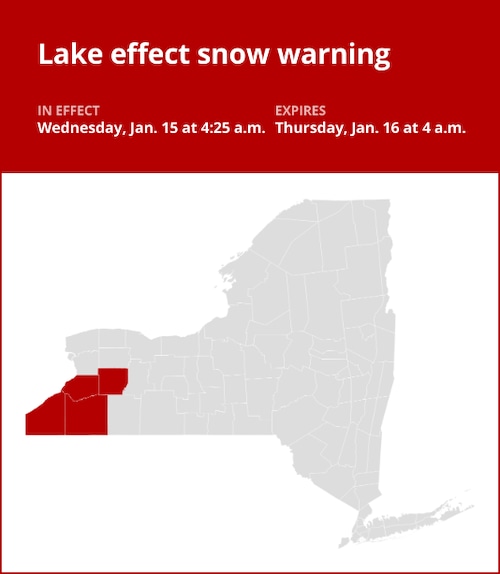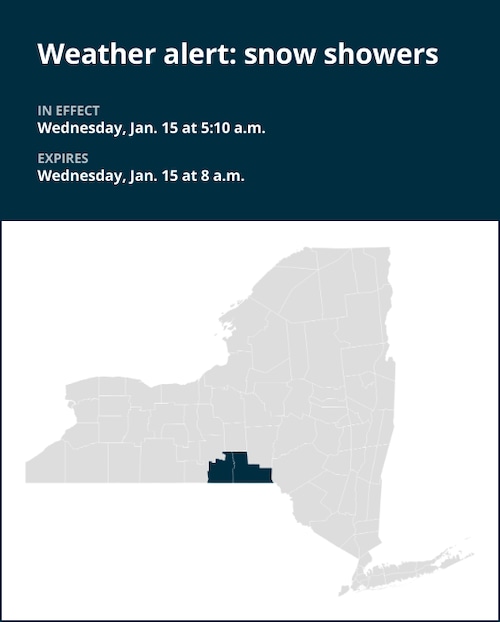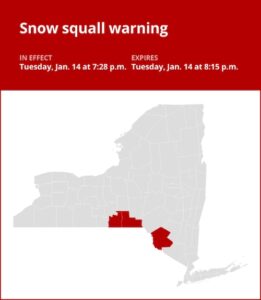At 8:22 p.m. on Tuesday, the National Weather Service released a bulletin predicting snow squalls in Broome and Sullivan counties through 10:30 p.m.
“In the southern tier of New York and far northeast Pennsylvania, the snow squall that has been gradually drifting south has begun to wane. From 8:30 p.m. to 9:00 p.m., this squall will continue to impact I-81 close to the NY-PA border. Before further lake effect snow showers return to the area late tonight and Wednesday early, expect the snow showers and squalls to taper off between 9 and 11 p.m. If you are traveling, be ready for roads that are coated with snow, slick, and have less visibility. The weather agency advises being cautious and giving yourself more time to get to your destination.
Snow squalls: Risks, differences, and safety seasures
What are snow squalls?
Strong cold fronts are frequently associated with snow squalls, which are short but intense winter weather phenomena. Even in the absence of a significant winter storm, they can quickly result in icy roads and unexpected whiteout conditions. Even while they often last less than an hour and may only cause slight snow accumulation, their reduced visibility, strong winds, and quickly dropping temperatures make them extremely dangerous for driving. In the past, these circumstances have resulted in fatal traffic accidents.
What is the difference between a snow squall and a snowstorm?
A snowstorm and a snow squall differ primarily in their strength and length. Usually lasting 30 to 60 minutes, snow squalls are short yet fierce. A snowstorm, on the other hand, can last for several hours or even days.
Snow squall warnings
Similar to tornado and severe thunderstorm warnings, snow squall alerts are short-fused and targeted at specific locations. These alerts offer vital, extremely targeted information that can save lives. If your neighborhood is under a snow squall warning, stay indoors or postpone driving until the squall has passed.
Actions during a snow squall warning
When a snow squall warning is issued, people should heed the weather service’s instructions, which include the following crucial steps:
Avoid or postpone travel: If your area is under a snow squall warning, stay indoors or wait for the squall to pass through before driving. During a snowstorm, there is absolutely nowhere safe to drive on the roadway.
Decrease speed and improve visibility: If you are already traveling and won’t be able to get off the road in time, slow down and activate your headlights and hazard lights.
Keep a safe distance: Make sure there is enough space between your car and the one in front of you. In order to account for decreased vision and the possibility of unpredictable road conditions during a squall, this precaution is crucial.
Steer clear of quick braking: Sudden braking can cause a vehicle to lose control in icy and slippery conditions. To reduce the chance of sliding or producing a chain reaction crash, it is safer to reduce your speed gradually.
Winter weather safety advice: Go to the weather service’s Winter Weather Safety page for advice on how to be safe before, during, and after a winter storm.
Prepare your car: Take proactive steps to get your car ready for winter driving conditions before you leave. This entails making sure your car’s fluids are topped off and inspecting your tires, brakes, and lights. The difficulties of winter driving are better handled by a well-maintained car.
Essentials of an emergency kit: Make sure your car has a complete emergency kit that includes supplies like water, non-perishable food, blankets, a flashlight, and a first aid kit. To improve tire traction, don’t forget to have jumper cables, flares or a reflective triangle, ice scraper, a map, a car cell phone charger, and cat litter or sand. In the event of an emergency or unplanned breakdown while traveling, these provisions may prove to be quite beneficial.
In conclusion, putting one’s own safety first and following the weather service’s advice can greatly reduce dangers when a snow squall warning is in effect. People can travel through these winter dangers with more assurance and security if they are aware of them, plan beforehand, and remain alert.
United Robots offers a service called Advance Local Weather Alerts that gathers the most recent information from the National Weather Service using machine learning.







+ There are no comments
Add yours